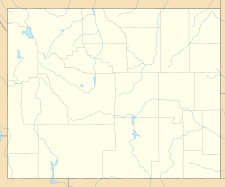Petersen Glacier facts for kids
Quick facts for kids Petersen Glacier |
|
|---|---|

Mica Lake and Petersen Glacier
|
|
| Type | Mountain glacier |
| Coordinates | 43°46′44″N 110°50′50″W / 43.77889°N 110.84722°W |
| Terminus | moraine |
| Status | unknown |
The Petersen Glacier is a small glacier located in Grand Teton National Park in Wyoming, USA. It sits high up in a bowl-shaped valley called a cirque, above the north side of Cascade Canyon. This glacier is known for its connection to Mica Lake, whose waters get a special turquoise color from the glacier's runoff. Sadly, recent satellite images suggest that Petersen Glacier might have completely disappeared.
Contents
Petersen Glacier: A Vanishing Ice Wonder
Petersen Glacier is found in a beautiful and rugged part of Grand Teton National Park. It rests at a very high elevation, about 10,000 feet (3,048 meters) above sea level. Glaciers are like slow-moving rivers of ice. They form when snow piles up over many years and gets compressed into ice.
Who Was Frank Petersen?
The glacier is named after a brave man named Frank Petersen. He was one of the first mountaineers to successfully climb Grand Teton mountain. This amazing climb happened way back in 1898. Naming the glacier after him honors his adventurous spirit and his connection to the park's history.
The Mystery of Mica Lake's Color
One of the most interesting things about Petersen Glacier is how it affects Mica Lake. As the glacier slowly moves and grinds against the rocks, it creates a very fine, powdery material. This material is called rock flour or glacial silt. When the glacier melts, this rock flour washes into Mica Lake. The tiny particles of rock flour in the water scatter sunlight in a special way. This scattering makes the lake appear a bright, beautiful turquoise color.
Glaciers in Grand Teton National Park
All the glaciers you can find in Grand Teton National Park today were formed during a period known as the Little Ice Age. This was a time when the Earth experienced cooler temperatures, roughly between the years 1350 and 1850. Since the mid-1800s, most glaciers around the world, including those in Grand Teton, have been shrinking. This shrinking is called "retreating." The fact that Petersen Glacier might no longer be visible shows how much these icy giants are changing.


